Feature adoption and product adoption are distinct concepts in the realm of user adoption and product development. While they share the common goal of increasing user engagement and satisfaction, they differ in scope and focus.
TL;DR: Feature adoption looks at how well specific features are being utilized by users, whereas product adoption evaluates the overall acceptance and usage of the entire product.
What is feature adoption?
Feature adoption zooms in on the specific functionalities or components within a product or service. It tracks how well users are embracing and utilizing individual features or updates within the broader product. Think of it as a micro-level analysis of user behavior within a product.
For instance, if you introduce a new messaging feature in a social media app, feature adoption metrics would assess how many users actively use this feature, how frequently they engage with it, and whether it enhances their overall experience.
Feature adoption is particularly valuable for product teams looking to optimize the utility of their offerings. By measuring feature adoption, they can identify which elements of their product resonate most with users, gather feedback on feature-specific experiences, and prioritize improvements accordingly. It allows for fine-tuning and refining the product on a granular level.

What is product adoption?
Product adoption, on the other hand, takes a broader view by evaluating the overall acceptance and usage of the entire product or service. Rather than focusing on isolated features, it assesses how well the entire offering aligns with user needs, expectations, and goals. It's a macro-level analysis of whether users are deriving value from the product as a whole.
In the context of a social media app, product adoption would consider how many users engage with various features, the overall time spent on the platform, and whether users are satisfied with the comprehensive experience.
Product adoption is critical for businesses aiming to understand the holistic impact of their product on user engagement and retention. It encompasses user satisfaction with the product as a whole and helps identify areas where the entire offering can be enhanced.
Successful product adoption indicates that users are finding value not only in individual features but also in the overall ecosystem, which often translates into long-term loyalty and positive word-of-mouth.

How to measure product adoption
Measuring product adoption helps you figure out how much users are really getting into your product. You can do this by looking at a few important metrics. You can look at things like the "Product Adoption Rate," which tells you what percentage of your users are actually using your product.
You should keep an eye on how often users are engaging with your product and what they're doing with it. Surveys and feedback from customers can give you an idea of how happy they are with your product and what needs improvement.
KPIs for this include:
- Customer satisfaction scores (CSAT),
- Net Promoter Score (NPS), and
- Customer lifetime value (CLTV).
Tracking how many users stick around over time tells you if people are finding your product valuable. By keeping tabs on these factors and using the insights to tweak your approach, you can boost product adoption and keep users coming back for more.
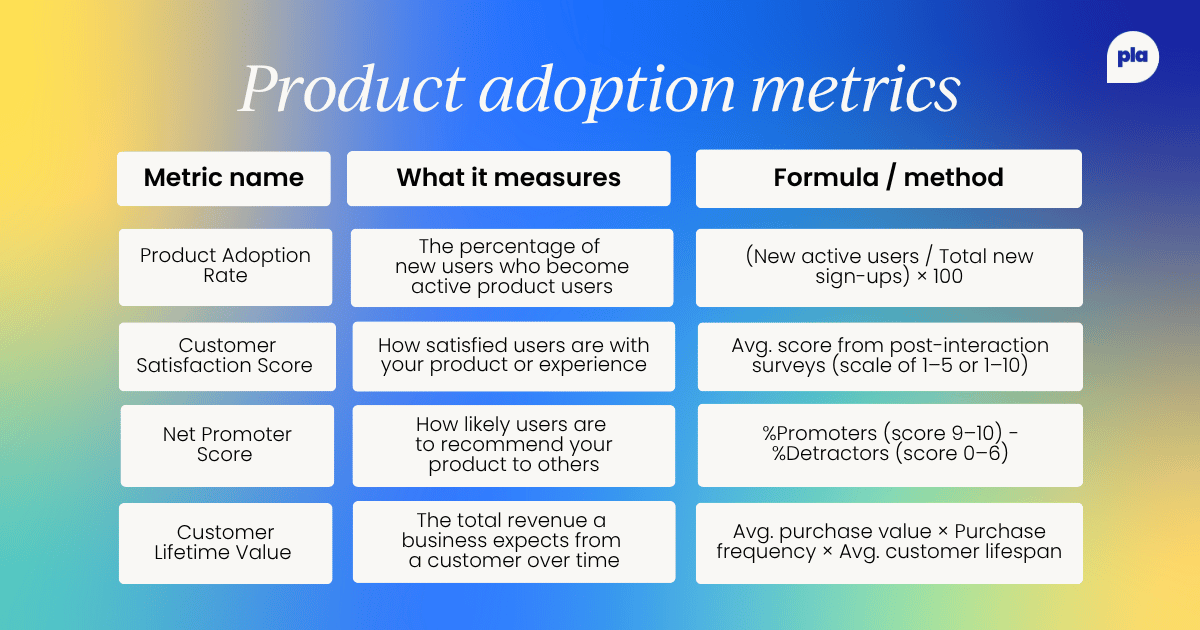
Feature adoption metrics
Feature adoption metrics are the yardstick for assessing how well users are embracing specific features within a product or service. These metrics provide a clear picture of user behavior and engagement on a micro-level.
Key feature adoption metrics include the "Feature Adoption Rate," which tells you the percentage of users who have started using a particular feature, and "Feature Engagement," which measures how often users interact with the feature.
User feedback and surveys can offer valuable insights into their satisfaction and pain points with specific features, guiding product teams to make targeted improvements.
Other useful metrics include:
- Time to adopt: How long it takes users to start using a new feature after it's launched.
- Frequency of use: How often users return to a feature once they've used it.
- Retention and drop-off: Whether users continue using a feature or abandon it after one try.
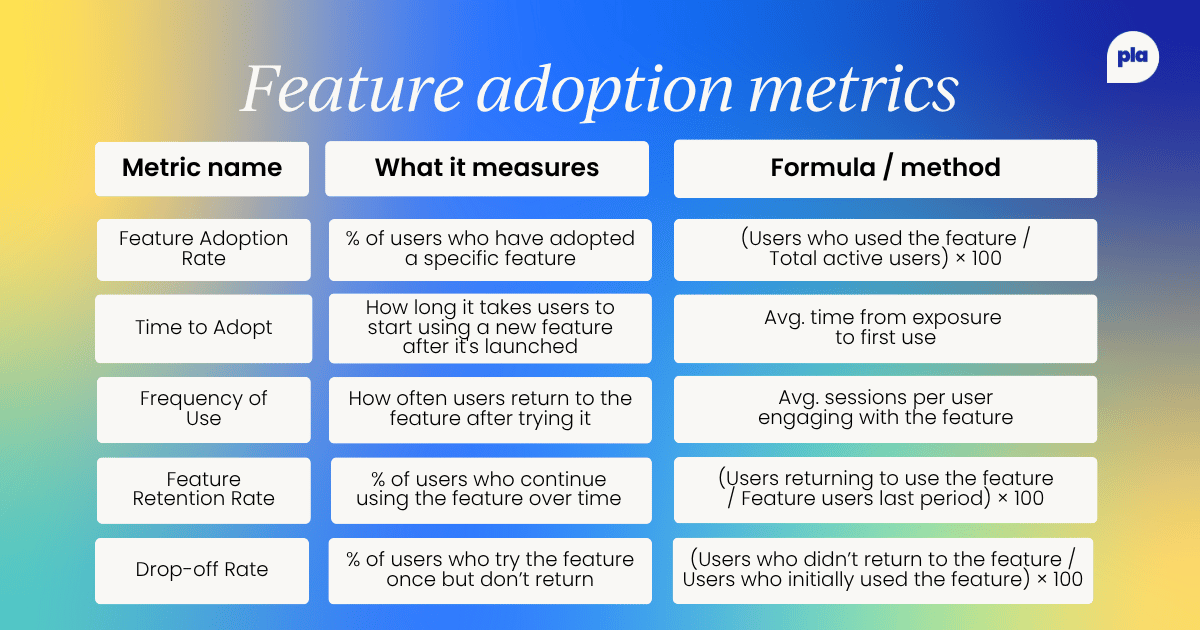
Product adoption strategies
Creating an effective product adoption strategy involves a multi-faceted approach that prioritizes user satisfaction and engagement. The following strategies reflect a combination of proven frameworks and expert insights.
Understanding user needs
One of the primary challenges in product adoption lies in understanding the needs and pain points of the target audience.
As Maggie Crowley, Senior Director of Product Management at Drift put it, "The key to getting a tight job to be done is a deep understanding of your customers. It's the number one most important place to start.
"You have to talk to them. You have to talk to them live, you yourself, have to talk to them as a product manager."
Product teams that succeed in adoption often start by validating demand.
"As a startup, my recommendation to you would be: ask your potential market lots of questions about how valuable they find your idea and how they currently solve that problem with other tools." – Ariel Combs, Head of UX Research at Full Story.
Understanding user motivations allows businesses to clearly communicate their value proposition.
As Ishita Das Sarkar, Associate Director at Prescient Healthcare Group, puts it: "Businesses must communicate their value proposition to the target audience – how the product solves a problem or fulfils a need better than existing solutions."

Optimizing first impressions and onboarding
First impressions can determine whether a user becomes a long-term customer or drops off.
"Activation is usually defined as the moment when a user experiences the value of the product for the first time. Some also call this an 'aha' moment." – Konstantin Valiotti, Product Director of Growth at PandaDoc.
To get users to that moment quickly Konstantin suggests:
- "Eliminate friction. The less friction, the easier it is for the user to extract the value."
- Align the top of the funnel by "changing your website to showcase your product more prominently" and "showing your product in ads."
- Use "pre-built assets" or a "pre-generated experience" (such as sample data or guided tours) to help users discover value even if they are only evaluating the solution.
A seamless and intuitive onboarding experience is paramount according to Ishita, who affirms: "Complicated onboarding processes, confusing interfaces, slow performance, and technical glitches can frustrate users and deter them from embracing a new product."
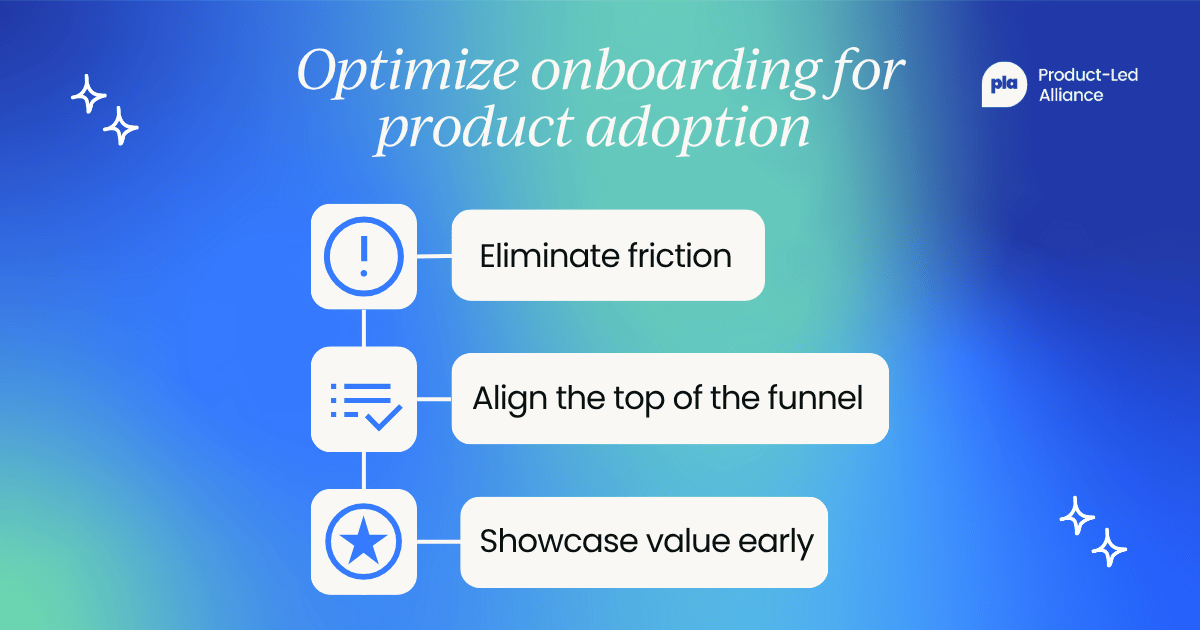
Leveraging early access programs (EAPs)
Early access programs are a powerful way to build with customers, not just for them. Maggie explains how Drift uses EAPs:
"We use a tactic called early access, which means picking a small handful of customers to partner with to finish building the thing that you're working on."
This process is most effective when you remain flexible: "You have to change what you're doing based on their feedback. You have to leave time and space – especially emotional space – for your customers to decide what you're doing is not exactly what they wanted."
Launch and post-launch strategies
A successful launch isn't about listing technical specs. Instead, Maggie’s team "launch by telling the customer story, not the story of your product or its technology."
To manage demand, they "launch publicly, but then limit the release." This approach generates interest while allowing for controlled scaling.
Finally, remember Ishita’s wisdom: "Product adoption is not a one-time event but an ongoing process that requires continuous support and maintenance."
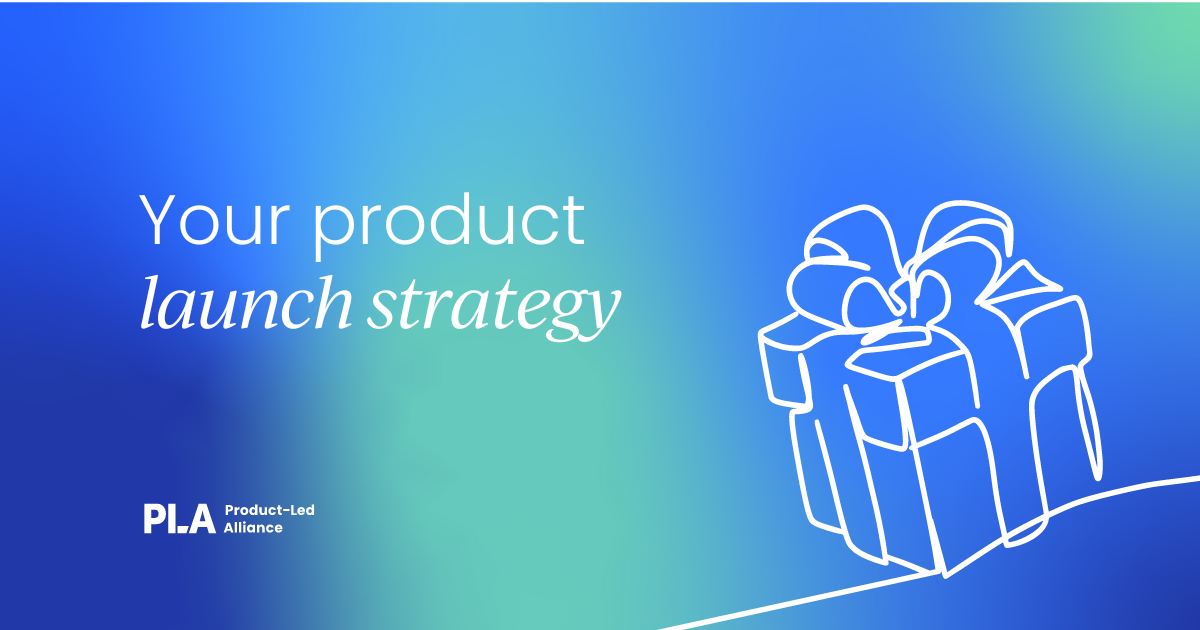
Feature adoption strategies
Feature adoption focuses on encouraging existing users to discover, try, and consistently use specific features within a product. A good strategy ensures not only awareness but continued usage and satisfaction.
Defining success and incentivizing teams
To drive ownership and accountability, it’s critical to define success upfront.
Aditya Gaur, Director of Engineering at Sumo Logic explains: "Before we roll out that feature, we define what the success criteria is for feature adoption. Defining this early gives us visibility of whether we've been successful or not."
Team incentives also play a role. Aditya shares how this works at Sumo Logic: "We reward individuals for feature adoption, rather than the number of features that they have worked on." So, instead of evaluating portfolios by volume, the org "looks at the actual customer impact that [engineers/product managers] have had."
This approach builds accountability: "Designing incentives in that way also builds a sense of ownership among our people. They will continue to monitor it, they will continue to own it – and own the adoption of it.
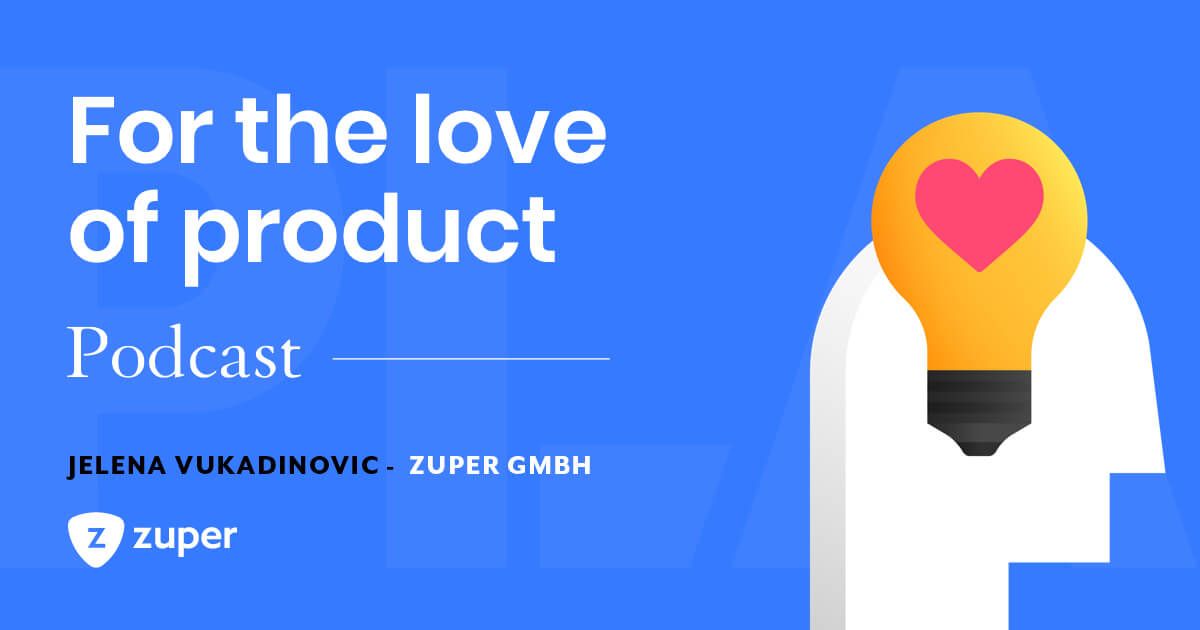
Targeted communication and marketing
One key tactic for driving adoption is making sure users see the right feature at the right time.
For example, when a customer becomes a power user, you could create a marketing mechanism to present a new feature to them just at the right point in their journey with your product.
Pre-launch communication is also vital. You can get the word out prior to launch by utilizing email notifications, on-screen popups, and adding tutorials or demos to your site.

Detecting user intent and proactive guidance
Detecting what a user is trying to achieve helps you surface relevant features. "The most important thing you can do as a product builder... is to detect user intent and get really explicit about them." – James Evans, CEO of Command Bar.
One clever solution? The power of that search bar. According to James, companies like Gusto use federated, natural-language search to understand user needs and expose relevant features.
Once intent is detected, the next step is guidance – but it has to be done carefully. "We find the key to wielding proactive experiences effectively is essentially to be non-annoying."
This can take many forms:
- "Prompt the user" with checklists or suggestions.
- Let users go on "side quests."
- Use smart modals or tooltips "at just the right time."
- Combine guidance with data collection: "You can get a lot more signal on what a user is trying to do."
These methods ensure users not only discover new features but also understand and appreciate their value – without being overwhelmed.

Crafting a feature adoption strategy (3 steps)
When it comes to crafting a successful feature adoption strategy, several key principles come into play.
- Adopt a user-centric approach
Adopting a user-centric approach is paramount. To do this effectively, it's essential to thoroughly grasp your users' pain points and preferences, ensuring that feature development aligns with their needs and desires.
- Gradual rollout
Secondly, implementing a gradual rollout strategy is key. This approach minimizes disruption, allowing for the collection of valuable user feedback before a full-scale feature release.
- User education
User education is also important in boosting feature adoption. Providing user-friendly resources such as guides, tutorials, and in-app notifications helps users understand new features and appreciate the benefits they bring to the overall user experience.
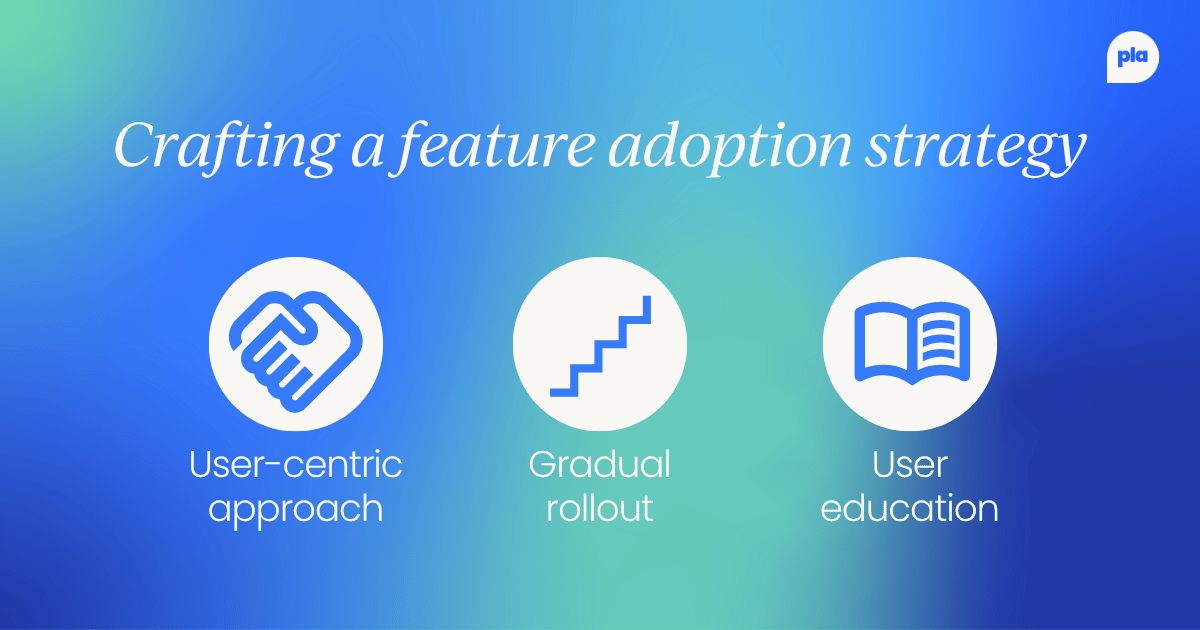
Tools for measuring product and feature adoption
To effectively measure and improve adoption, product teams rely on specialized tools that combine analytics, onboarding, user feedback, and in-app engagement.
These platforms help surface usage patterns, identify friction points, and trigger actions that boost adoption.
Here are some of the most widely used tools in the space:
- Pendo – Combines product analytics with in-app guides and surveys to track feature usage and prompt users with onboarding flows or announcements.
- Mixpanel – Offers advanced event tracking and cohort analysis, making it easy to measure metrics like time-to-adopt, retention, and drop-off.
- Userpilot – Enables no-code onboarding experiences (like tooltips, modals, and walkthroughs) while tracking how users interact with specific features.
- Amplitude – Powerful product analytics platform with behavior funnels, conversion tracking, and impact analysis for new features.
- Appcues – Focuses on personalized onboarding and feature announcements with robust targeting and segmentation capabilities.
These tools allow teams to go beyond static metrics by embedding experimentation, segmentation, and proactive guidance directly into the product experience.
They’re especially useful in product-led growth environments, where driving feature discovery and repeat usage is key to retention and expansion.

Product adoption vs feature adoption frameworks
Product adoption frameworks
Product adoption frameworks are essential tools for businesses to understand, measure, and improve the acceptance and usage of their products among users.
One widely recognized example is the AARRR framework, also known as Pirate Metrics. This framework breaks down the user journey into five stages:
- Acquisition (how users find your product)
- Activation (users' initial experience with your product)
- Retention (keeping users engaged over time)
- Revenue (monetizing users)
- Referral (encouraging users to refer others)
Another example is the HEART framework, developed by Google, which focuses on user happiness and can include metrics related to happiness, engagement, adoption, retention, and task success.
These frameworks provide a structured approach for businesses to assess product performance, identify pain points, and make data-driven decisions to enhance user experiences and drive growth.
Feature adoption frameworks
Feature adoption frameworks are indispensable tools for businesses to gauge the success of individual features or functionalities within their products. These frameworks offer a structured approach to assessing how well specific features resonate with users and contribute to overall product adoption.
One common example is the RICE framework, which stands for:
- Reach
- Impact
- Confidence
- Effort
This framework helps prioritize feature development by quantifying the potential impact and effort required for each feature. Feature adoption frameworks often involve tracking metrics such as the feature adoption rate, feature engagement, and user feedback specific to particular features.
By using these frameworks, organizations can make informed decisions about which features to prioritize, allocate resources effectively, and tailor their strategies to improve the adoption of individual components within their products.
Conclusion
While both feature adoption and product adoption are essential for product development and user satisfaction, they differ in scope.
Feature adoption drills down into the performance of specific functionalities, while product adoption provides a comprehensive view of user engagement with the entire product. Understanding these differences is key for businesses seeking to optimize their offerings and enhance the user experience.



 Follow us on LinkedIn
Follow us on LinkedIn










